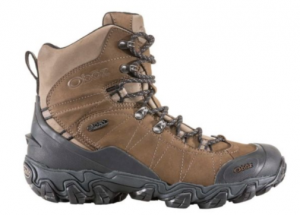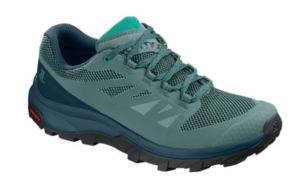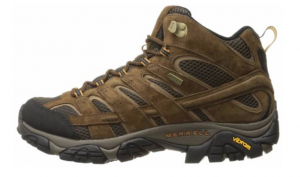When it comes to hiking footwear, there’s a dizzying amount of options out there. Inevitably, the question of whether you should go for a mid cut, low cut, high ankle boot, or even sandals will come up.
Footwear Schools Of Thought
There are several schools of thought on the topic: hardcore boot enthusiasts will insist that the only safe option is rugged, high-top, seemingly bombproof hiking boots. Ankle support, they’ll tell you, is of utmost importance.
On the other hand, there’s a growing contingent of hikers who swear by low-profile trail running shoes, preferring the lighter and more streamlined design.
And then, there are the sandal advocates, who find the fresh air between their toes liberating, arguing that the only real necessity is a strong sole and comfortable straps.
So, what’s best? Sturdy, high- or mid-cut boots that may weigh extra but could protect your vulnerable bony ankles? Or perhaps the sleek, lightweight trail runners that will make you fly down single-tracks with ease?
First, let’s dive into the different types of footwear and ankle support.
High Ankle, Low Cut, Mid Cut Boots/Shoes – What Are They?
High Ankle
- High-ankle boots will be the most sturdy of hiking footwear options. These boots have a cuff that rises a few inches above the ankle bone, with laces that will keep the collar snug to your leg. The material can vary from leather to a mixture of leather and rubber, depending on style and brand. They are often mostly waterproof, designed to keep your feet dry in muddy conditions, rainstorms, or on snowy trails.
- One additional feature of high ankle boots is that they often have a metal lacing hook that allows for the tightening of laces to be a bit easier at the higher ankle levels.
 High Ankle Boot Example
High Ankle Boot Example
Oboz Bridger 8″ Insulated Waterproof – On Amazon – On REI
- High Ankle Hiking Boot Example 2
Low Cut
- A low-cut shoe will provide the greatest range of motion whilst hiking, but will leave the ankle bone exposed to the elements. Popular low-cut options for hiking tend to be trail runners, made from a blend of synthetic, lightweight materials that allow for flexion and ease of movement.

- Low Cut Hiking Shoe Example
Mid Cut
- Mid-cut hiking shoes are a hybrid between the previous two options. They’ll typically rise just above the ankle, providing more protection from the elements and will keep your ankles safe from cuts or abrasions. They’re also typically made from a hybrid of leather and rubber, tend to be more sturdy than trail runners, but with more flexibility than high-cut boots. Often, they’ll provide similar waterproofing as higher cut boots, but with more freedom of movement.

- Mid Cut Hiking Boot Example
*Disclaimer: The above contains affiliate links, meaning we get a small commission if you purchase through those links. These are just examples of boots in each category for you to see and look around. They happen to be models and reputable brands that we have tried and had success with.
Our Process For Helping You Choose
To help determine what’s the best style of footwear for each situation, we asked two strong cohorts of hard-core hikers: Women of the Pacific Crest Trail and Hiking Colorado Facebook groups. We also took a look at footwear studies (references at bottom of post), and incorporated our own general knowledge to help you make the best decision.
Ankle Stability in Low Cut, Mid Cut, & High Ankle Boots
Despite what you may think, if you have a history of ankle issues, those high-top boots won’t necessarily save your ankles. A 2014 study conducted by the Journal of Foot and Ankle Research found that high-top shoes may actually have a detrimental effect on ankle stability.
In the study, researchers found that the shoe collar height didn’t influence ankle stability when participants landed on a tilted surface. High-top shoes could actually prevent ankle muscles from engaging; “…this might be detrimental to establishing and maintaining functional ankle joint stability in ankle strain situations,” the study reads.
Based on the study’s findings, ankle stability need not be a factor when choosing footwear. The true benefit of high- or mid-cut versus low-cut is in the way they can protect from the elements, not to mention pesky rocks and other debris that may try to sneak into your shoes while you cruise down the trail.
What Avid Hikers Think
From the PCT group, about a dozen women responded with nearly unanimous answers: trail running shoes, all the way, they said. Now, there are some good reasons for lightweight shoes for those doing the 2,650-mile PCT: many people are going for huge distances each day, which means they’re of the light-and-fast mentality. Also, they’re typically hiking in warmer/dryer seasons, so waterproof shoes aren’t always a necessity.
Judy Flexer has been an avid hiker for over 50 years. She started section-hiking the PCT 15 years ago, and has completed 2,400 miles of it with her husband. She plans to complete her final 274 miles this year.
“It’s been trial and error,” Judy said of her experimenting with footwear. She started as many do, with stiff leather boots. When she started section-hiking the PCT, however, she switched to trail runners, and said she wouldn’t go back. In fact, she kept going lighter and lighter every few years, and ended up with a shoe so lightweight that it gave her plantar fasciitis and tendonitis in her feet. The injury hasn’t changed her feelings about trail runners, but she now wears a stiffer shoe that prevents her from bending at mid-foot.
Another PCT hiker Connie Westbrook agreed, saying that when she switched to trail running shoes, it was the first time she didn’t get heel blisters or felt pain in her feet, even when wet.
And then there were the minimalists, with two women saying sandals were their go-to.
For thru-hikers, it’s all about speed, so it’s common to see most PCT hikers in lightweight footwear. Heavy hiking boots tend to slow you down, as the Sir Edmund Hillary adage declares, “a pound on your feet equals five on your back.” In fact, it has scientific backing: a study from the US Army in the 1980s found that even small increases in the weight of footwear requires higher energy expenditures for walkers and runners.
So, what’s the argument for boots?
For one, if you’re hiking in shoulder seasons or winter and know you’ll encounter some snow or colder temps, the higher the cut, the more protection and warmth you’ll achieve. A waterproof boot will allow you to get through stream crossings or the occasional snow patch with far more ease and comfortability than low-cut trail runners.
Another factor to consider is the weight on your back: high- or even mid-cut boots can provide more general stability and comfort if you’re carrying a huge pack with a week’s worth of food and supplies. Higher-cut boots are also typically made from sturdier materials than most trail runners, so will likely last longer.
Hikers from the Hiking Colorado group also weighed in, many saying they like to have both high- and low-cut boots in their closet so they can dress to the conditions.
“My low profile shoes feel more like sneakers and weigh much less, which I prefer, especially for shorter hikes on well groomed trails,” hiker Amber DeAnn said. “Anything not well groomed, snow, mud, ice, etc., and I throw on the boots.”
Aaron Smith said he only uses boots on snowy ascents. For most of the year, he’s in trail runners, especially if he’s covering distances over 10 miles. “A lighter pack allows for light footwear,” he said.
Another group member, Kevin Munson, said he’s a fan of the higher cut shoes for backpacking, enjoying the sturdiness they provide. But, he’ll typically opt for the trail runners when he’s not hiking with a lot of gear on his back.
Chelsea Reese said she highly recommends that you try shoes before you buy, because she can’t stand the feel of mid-cut shoes on her ankles. “I went for a hiking shoe that looks like a hiking boot, but in the shape of a tennis shoe,” she said. “I love actual boots too. That dang mid-rise though!”
Choosing The Right Footwear For You
So, what footwear is best for you? There are several factors to consider.\
Terrain: One of the first considerations should be evaluating the terrain where you’ll be hiking. If you’re bush-bashing, river-crossing, or mud-mucking, you may want the sturdy protection that a boot can provide. Even though they may not do much for ankle stability, the high-tops could save your ankles from the elements. However, if you’re headed out on a summer hike to bag 10 miles on a well-packed and flat single track, trail runners would be a better option for both speed and comfort.
- Flat terrain: You can typically get away with low-cut shoes on flat terrain, unless you’re moving through muddy, icy, or snowy conditions that require more warmth and protection. High-cut boots may slow you down here, but could provide some sense of comfort if the trail conditions are rough.
- Heavy elevation changes: Low-cut shoes will provide the greatest amount of flexion if you know you’ll be scaling some rocky terrain and you want to move quickly. However, if your trail brings you above the snowline, make sure you have a shoe that can withstand the colder conditions, with waterproof lining and sturdy soles for the changing landscape.
- Rocky terrain: While higher-cut boots may not provide greater ankle stability, you may appreciate the protection from bruising or cuts that could come with hiking in rocky terrain. Plus, a sturdier sole will protect the bottom of your feet from the uneven ground. However, if you’re trying to move quickly, your low-cut runners will give you the most flexion and maneuverability.
- Dirt paths: A dirt path is typically pretty low-impact on the foot, so you could be plenty comfortable in low-cut, flexible shoes. But if you’re looking to keep your feet from getting caked in dirt, opt for a sturdier material, as some trail runners have thinner outer materials, letting in finer dirt particles.
- Wet conditions: There’s nothing worse than trench foot, so this is an important one. There are also a couple schools of thought on this: thicker hiking boots are often mostly waterproof – to an extent. I once did a river crossing in a new pair of hiking boots, which immediately filled with water and became ten times heavier. They took two days to dry, and I was incredibly uncomfortable for the rest of the trip. Had I been wearing trail runners, they would have been much lighter even when wet, and would have dried much more quickly. However, If you’re only dealing with rain and no major crossings, your boots will likely keep you dry, but in the future, I’d opt for lighter footwear for deeper river crossings.
- Snowy conditions: For any snowy terrain, leave the trail runners at home. Mid- and high-cut boots will keep you warmer, dryer, and will allow you post-hole without feeling like your feet will turn into chunks of ice.
- Snake territory, cacti areas, and tall grass: If you’re venturing into areas where snakes are a concern, or there’s some harsher vegetation such as cacti or tall, deep grass, grab the ankle-protecting shoes. You’ll be less likely to need your First Aid Kit or anti-venom…
- Weather: Similar to terrain considerations, weather can be a big influencer of shoe choice. For example, winter hiking means you could encounter everything from muddy slush puddles to sheer ice; maybe even a little post-holing, depending on how recently it snowed. High-top hiking boots will keep you warmer, dryer, and help you feel a little sturdier on your feet. But, if you know you won’t be encountering any snow or ice, the lightweight runners might be the go-to, depending on your terrain.
- Experience: If you’re new to hiking, you might feel more confident with boots. The wider and thicker soles can bring confidence to a newbie, requiring a little less agility than low-profile trial runners.
- Speed: This is a big one, as boots can add unnecessary weight to your frame. A little extra weight when you’re casually meandering through the mountains shouldn’t make a big difference to your day. On the other hand, if you’re thru-hiking the PCT, every pound matters. Hardcore hikers will look for every opportunity to slash weight, some even chopping their toothbrush down to shed extra ounces. If you’re going for mileage, find a comfortable pair of trail runners or lighter pair of mid-cut shoes; you’ll likely pick up speed once you shed the boots.
- Foot health: If you’ve had foot injuries in the past (broken toes, tendonitis, or plantar fasciitis for example), you’ll want to consider that when you choose footwear. This doesn’t pigeon-hole you into needing boots, but may mean you should go for a stiff-soled trail runner, or one with structural integrity.
Conclusion
If you’re an avid hiker looking to experience a diverse range of trails from the backcountry to the frontcountry, it’s a good idea to invest in both a pair of boots and a pair of trail runners. You’ll be able to head into any terrain or objective with more confidence, and will likely come away with a greater knowledge of your capabilities.
References
Study on weight of boots and performance: https://www.tandfonline.com/doi/abs/10.1080/00140138608968276
Study on ankle stability and high- vs low-top shoes: https://www.ncbi.nlm.nih.gov/pmc/articles/PMC3943374/
Meghan Walker is a freelance writer who, when not writing about the outdoors, is typically climbing in the canyons dotted along the foothills of the Front Range. Meghan has several year’s experience writing about the tramping (aka hiking) scene in New Zealand, where she avidly explored the trail and hut network that spreads over both the North and South Islands. As a recent transplant to Boulder, Meghan is now soaking up the plethora of outdoor opportunities in Colorado’s Rocky Mountains.
